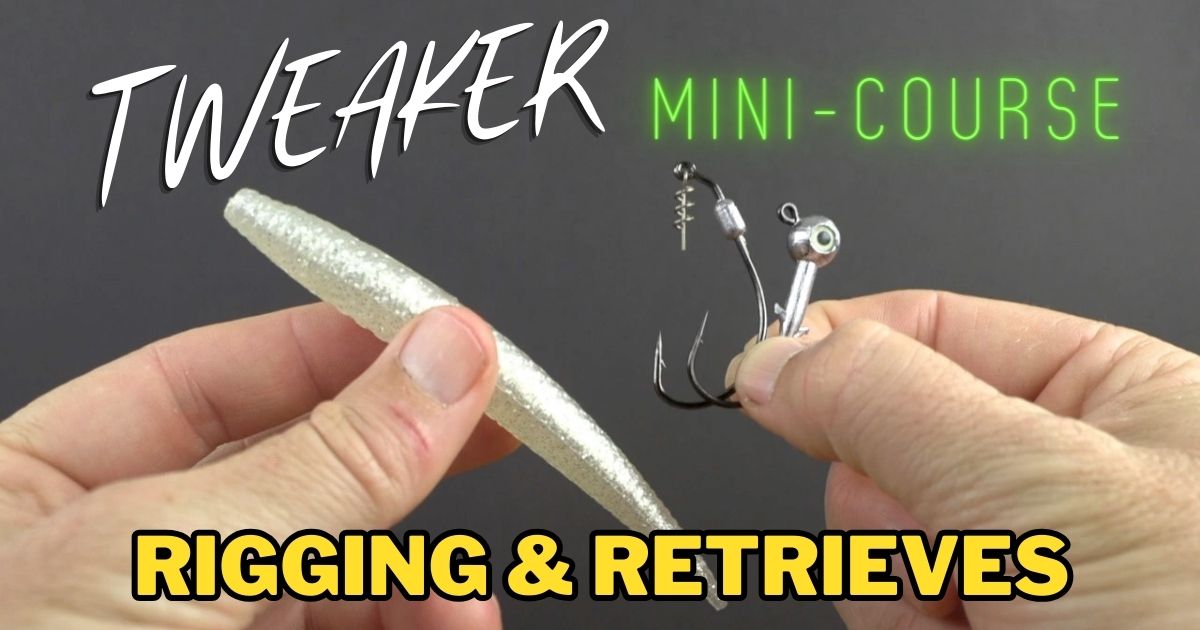Polk County Tweaker Lure Mini-Course [Rigging, Retrieving, & More]
- By: Luke Simonds
- on

The Polk County Tweaker is a new jerk-style lure specifically designed to catch redfish, seatrout, snook, and flounder even if they aren’t hungry.
This lure has a great darting motion when retrieved with a twitch-twitch-pause motion that causes predator fish to strike due to their instinct to take advantage of injured prey.
The only con of this lure is that it is not for beginners because it requires skill to get the right action in the water… if you’re a beginner, you need to start out with The 2.0 paddletails because they are much easier to use.
But if you’re ready to take on a more advanced lure, here’s a mini-course so that you can see exactly how to rig and use this lure.
Here are the lessons you’ll see below:
- How to rig
- How to retrieve
- When to NOT use soft plastic jerk lures
- Ideal equipment for using soft plastic jerks (rod, line, & reel)
- Best knot to use
- How to repair bent/crooked lures
Just click on the respective videos below to see the details.
How To Rig Soft Plastic Jerk Lures
Here are links to my favorite rigging items for these lures:
Shallow Zones = Helix Weighted Hook (3/0 size fits best)
- 1/16 oz for 0 – 2 ft
- 1/8 oz for 1-3 ft
- 3/16 oz for 2-4 ft
Deeper Zones = Round Eye Jig Head (2/0 & 3/0 hooks)
- 1/8 oz for 2 – 4 ft
- 3/16 oz for 3 – 7 ft
- 1/4 oz for 5 – 10 ft
- 1/2 oz for 10 – 20 ft
Retrieving Soft Plastic Jerk Lures
When To NOT Use Jerk Lures
Soft plastic jerk lures are extremely versatile, so they can be successfully used in most situations. The times in which I recommend against them are the following:
- When lots of pufferfish are in the area (it’s best to go with a hard lure when puffers are around)
- When it’s very windy (these lures can be tough to retrieve properly in windy conditions, so going with something with more drag in the water is generally best (spoon or swimbait)
Ideal Equipment
Here’s a quick listing of the overall equipment that has proven to help maximize the results when using the Twitch lures:
Rod
I highly recommend 7’6″ Fast Action blanks with Medium power. Here are links to my 2 favorite combos for using soft plastic lures like The Twitch:
Line
I highly recommend using light braid for maximizing your results when using soft plastic jerk lures so that you can maximize your casting distance and feel of taps vs. thumps.
My personal favorite after doing a lot of line tests of the years is the 10 lb J-Braid 8 Grand because it is very strong, casts great, and has proven to hold up to a lot of abuse.
Reel
In my opinion, the reel is not nearly as important as the rod and the line. I recommend 2500-sized reels for inshore fishing with soft plastic jerk lures because they hold plenty of line and have more than enough drag strength while they weigh much less than the larger reels.
My personal favorite is the Daiwa Fuego 2500 XH because it’s super light and it holds up to saltwater exposure great for a reel under $100.
For lures like this, it’s best to use a loop knot so that you can allow the lure to have maximized freedom of motion in the water.
We recommend the Non-Slip Loop Knot since it’s quick to tie and it results in a tag end that points back towards the lure which ensures it won’t snag any floating debris.
How To Repair Bent Lures
No matter how well soft plastic lures get packed into a bag or tackle tray, there will always be some that end up getting bent out of shape.
The good news is that reforming them is very easy. Here’s a lesson showing tips on how to get any bent soft plastics back into good shape:
Conclusion
The Tweaker is a lure that can help you increase your consistency in catching quality fish because it flat out can generate strikes when fish aren’t hungry.
A key to success is to focus on both rigging and retrieving the lure properly because both are crucial.
When used properly, you’ll surely find that this lure will become one of your most trustworthy lures when fishing calm conditions where a silent darting lure shines.
If you have any questions, please use the Comment section below.
Tight Lines!
Related categories:
STOP WASTING TIME ON THE WATER!
Do what the “SMART ANGLERS” are doing and join the Insider Club.
Here’s what you’ll receive today when you join:
- Weekly fishing reports and TRENDS revealing exactly where you should fish every trip
- Weekly “spot dissection” videos that walk you through all the best spots in your area
- Exclusive fishing tips from the PROS you can’t find anywhere else
- Everything you need to start catching fish more consistently (regardless if you fish out of a boat, kayak, or land).










Excellent info, thanks.
Thanks so much Luke for the valuable info.
My pleasure! Glad to see that you enjoyed this video.
Awesome info on how to repair soft plastics that get slightly deformed.
Good info.
Hey Luke. An alternate rigging option when using weedless hooks is to position the slot of the lure on the top rather than the bottom. I’m not sure what purpose the slot provides on the bottom but when positioned on top, the hook point lays in the slot and is slightly lower than the rest of the bait material and makes it more weedless without having to skin hook the point.
The purpose of the slot is to allow for the lure to ride up the hook easier for a better hookset (less material on the hook allows for less friction).
Having the slot on the other side with the hook point inside it is certainly ok, but it decreases the hookup ratio since the hook will often have to be set through the lure before the hook point touches the fish.
Great to see the proper rod action for retrieval and speed/tempo.
Great video learned a lot
Perfect info on the twitch I really appreciate the weight depth chart.l now have made copies for my tackle boxes.i also learned how to reform bent baits which was great.thank you luke you were awesome mike j
Great videos, thanks. Look forward to trying the Twitch!
Great info. Thx